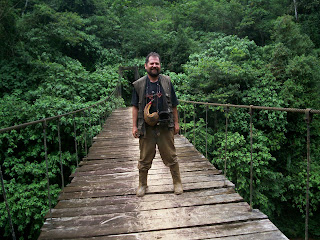The book Gold of the Gods by Erich von Daniken (1973) popularized this myth based on the accounts of Juan Moricz who claimed to have visited the cave and witnessed these exotic antiquities himself. The book and its assertions inspired the 1976 expedition of 100+ individuals including cavers, zoologists, biologists and archaeologists. Organized by Scottish explorer Stanley Hall, the Tayos Cave expedition was accompanied by astronaut Neil Armstrong as well.
Last November I wrote of my own expedition along the Ecuador/Peruvian border to a Tayos Cave led by a local Shuar guide, Ambale. Our trek was arduous - requiring an hour ride by boat up the turbulent rain swollen Rio Nangaritza to a Shuar village where we met our guide. He led us through the rainforest for three steaming hours to the cave, reminding us along the way of the vestigial mines strewn along the border from the 1995 Peru/Ecuador War.
Apparently there are several such caves, all occupied by Oilbirds and well protected by the Shuar people. Alex Chionetti, a scholar of lost civilizations, was polite enough to point this out.
While the 1976 expedition turned up no gold or metallic libraries, the caves still stir interest and hope that the legends may some day be proven fact. Alex knows this first hand and has journeyed to the cave twice to uncover its secrets.
 The Argentinian-born adventurer/independent filmmaker has been dubbed a "real life Indiana Jones" by the Spielberg/Lucas publicists for his exploits including one harrowing escape in March of 2007 when Chionetti's expedition was forced to run for miles through the jungle, leaving behind cameras, equipment and clothing as they fled from the Shuar who pursued with poisoned arrows. The Shuar (formerly known as the head-hunting Jivaros) who number only in the hundreds in this region, took exception to a non-aboriginal guide leading outsiders into their territory. The Tayos Cave along the Rio Coangos is is their "cathedral" where their God resides. It is the Mecca of the Shuar and they defend it ferociously, Chionetti says.
The Argentinian-born adventurer/independent filmmaker has been dubbed a "real life Indiana Jones" by the Spielberg/Lucas publicists for his exploits including one harrowing escape in March of 2007 when Chionetti's expedition was forced to run for miles through the jungle, leaving behind cameras, equipment and clothing as they fled from the Shuar who pursued with poisoned arrows. The Shuar (formerly known as the head-hunting Jivaros) who number only in the hundreds in this region, took exception to a non-aboriginal guide leading outsiders into their territory. The Tayos Cave along the Rio Coangos is is their "cathedral" where their God resides. It is the Mecca of the Shuar and they defend it ferociously, Chionetti says.

The main entrance is an 85 meter descent into the ground and extensive mapping already covers a 5 square km area. Chionetti says coastal tribes (related to the Valdivia culture) may have migrated to these caves in the past millennia based on ceramics, bones and spondylus shells specific to Pacific Ocean tribes that were found in the caves.
He's currently wrapping up a documentary on his experiences with Tayos and even plans to return to the cave in the near future. I would venture to guess with a new guide, the Shuar word for "my apologies" and maybe Jungle Pete?
While the 1976 expedition turned up no gold or metallic libraries, the caves still stir interest and hope that the legends may some day be proven fact. Alex knows this first hand and has journeyed to the cave twice to uncover its secrets.
 The Argentinian-born adventurer/independent filmmaker has been dubbed a "real life Indiana Jones" by the Spielberg/Lucas publicists for his exploits including one harrowing escape in March of 2007 when Chionetti's expedition was forced to run for miles through the jungle, leaving behind cameras, equipment and clothing as they fled from the Shuar who pursued with poisoned arrows. The Shuar (formerly known as the head-hunting Jivaros) who number only in the hundreds in this region, took exception to a non-aboriginal guide leading outsiders into their territory. The Tayos Cave along the Rio Coangos is is their "cathedral" where their God resides. It is the Mecca of the Shuar and they defend it ferociously, Chionetti says.
The Argentinian-born adventurer/independent filmmaker has been dubbed a "real life Indiana Jones" by the Spielberg/Lucas publicists for his exploits including one harrowing escape in March of 2007 when Chionetti's expedition was forced to run for miles through the jungle, leaving behind cameras, equipment and clothing as they fled from the Shuar who pursued with poisoned arrows. The Shuar (formerly known as the head-hunting Jivaros) who number only in the hundreds in this region, took exception to a non-aboriginal guide leading outsiders into their territory. The Tayos Cave along the Rio Coangos is is their "cathedral" where their God resides. It is the Mecca of the Shuar and they defend it ferociously, Chionetti says.
The main entrance is an 85 meter descent into the ground and extensive mapping already covers a 5 square km area. Chionetti says coastal tribes (related to the Valdivia culture) may have migrated to these caves in the past millennia based on ceramics, bones and spondylus shells specific to Pacific Ocean tribes that were found in the caves.
He's currently wrapping up a documentary on his experiences with Tayos and even plans to return to the cave in the near future. I would venture to guess with a new guide, the Shuar word for "my apologies" and maybe Jungle Pete?

No comments:
Post a Comment